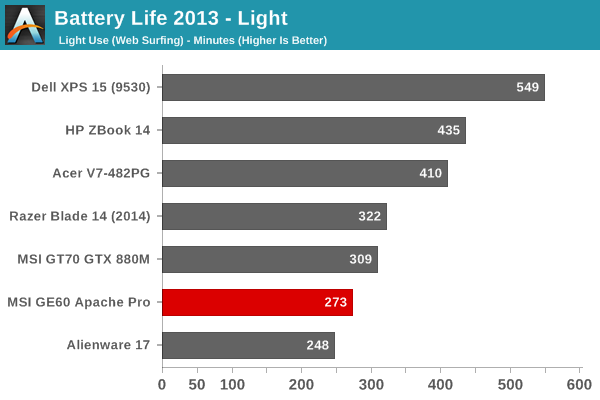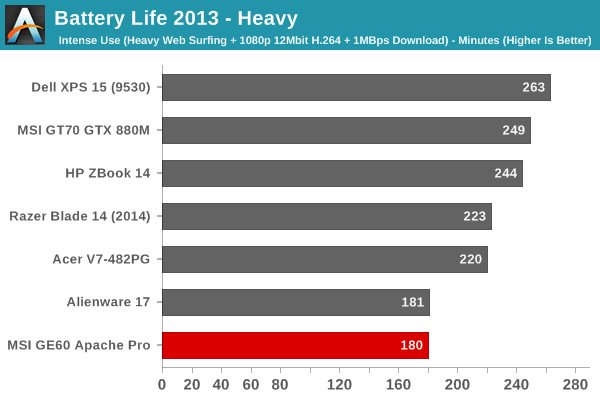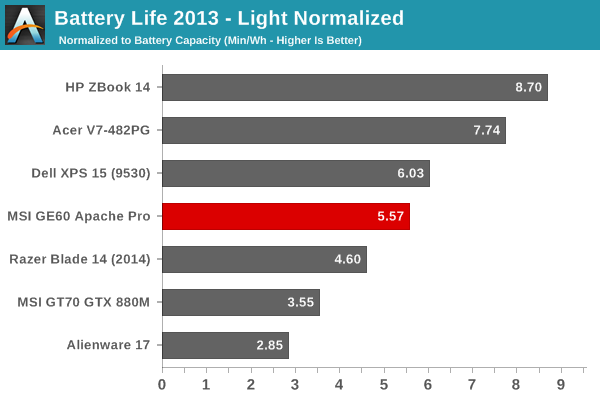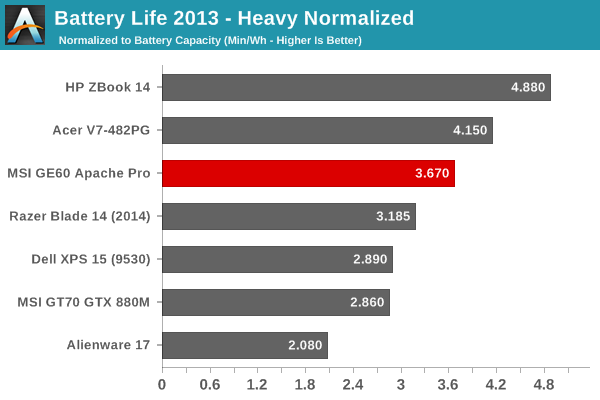MSI GE60 Review: Mainstream Mobile Maxwell
by Jarred Walton on July 17, 2014 5:00 AM ESTMSI GE60 Battery Life
As I mentioned earlier, battery life is the one area where the GE60 doesn't do so well. I wanted to spend some additional time investigating NVIDIA's Battery Boost technology, but with a relatively low starting point I'm not sure how much it can really help. Anyway, I'll get to that later. As usual, we have our Light and Heavy workloads.
One oddity is that the Heavy workload was consistently causing a BSOD with a VIDEO_SCHEDULER_INTERNAL_ERROR message after updating drivers. I'm not sure if the Intel or NVIDIA drivers are to blame, but I suspect it might be Intel's drivers as H.264 offloading tends to work just as well on Intel as on NVIDIA GPUs these days, so there wouldn't be much point in powering up the dGPU for video decoding. (Oddly, I haven't encountered this error on other laptops with Intel + NVIDIA solutions, so perhaps the problem is related to Maxwell and the specific workload we're running.)




The 49Wh battery isn't exactly large compared so other 15.6" laptops, but even so the battery life from the GE60 is pretty disappointing. Last year's GE40 managed to hit nearly nine hours with a 65Wh battery, so I was hoping to see at least more than six hours out of the GE60. I'm not sure if the root cause is BIOS/firmware related, or if some of the components (e.g. the LCD) simply consume a lot more power. Regardless, the GE60 manages 4.5 hours in our Light test and 3 hours in our Heavy test.
Power draw in the Light test looks to be around 10.75W (give or take), which isn't all that bad, but Dell's XPS 15 manages to support a QHD+ touchscreen LCD and still only consumes 9.9W in the same test, so there's definitely room for improvement. Dell also wisely chose to stuff in a 91Wh battery in their SSD-only XPS 15 model, which is nearly twice the capacity of the GE60's 49Wh battery. Things do improve a bit in the Heavy test, with the GE60 managing three hours compared to 4.38 hours – that means at a higher load the GE60 is drawing roughly 16.33W compared to the XPS 15 drawing 20.75W. And if you're curious about the current best result for power use, Sony's 13.3" VAIO Pro 13 only used 4.6W during the Light test and 11.4W in the Heavy test.
As for gaming battery life, without Battery Boost being enabled, you're looking at around 40-60 minutes, depending on the game and settings you're running. With Battery Boost, in some situations you might get close to two hours of gaming, but in most of my testing it looks like 60-75 minutes is a better estimate.










63 Comments
View All Comments
Flunk - Thursday, July 17, 2014 - link
I totally agree with you. I'd rather have a better experience typing than extra number buttons I'm not going to use all that often. If this was a business PC for accounting, perhaps the number pad would make sense.DanNeely - Thursday, July 17, 2014 - link
For everything work related except spreadsheeting, I'd rather have the arrows and navigation keys in the standard 104 key positions instead of smashed into the edge of the main area and scattered at random as fn-combos.JarredWalton - Thursday, July 17, 2014 - link
I use a 10-key enough that I'm happier with a full 104-key arrangement rather than 2-inch gaps on the right and left where keys could have been but aren't in the interest of centering the keyboard. YMMV.nathanddrews - Friday, July 18, 2014 - link
Indeed. I use the 10-key a lot for work and some games.Antronman - Thursday, July 17, 2014 - link
It's a gaming laptop, and some very popular games have mods or themselves take advantage of the numpad.Nagorak - Wednesday, July 23, 2014 - link
I use my numpad all the time. If the GE60 did not have a numpad I definitely would have had a hard time justifying my purchase of it.Khenglish - Thursday, July 17, 2014 - link
Have you looked at the W230ss? 13.3" clevo with 860m and 3200x1800 screen option.While it has a smaller screen, it's fatter than the MSI since clevo packed in the giant 12.7cfm fan that they use for GPU cooling on their bigger laptops.
emarston - Thursday, July 17, 2014 - link
I have the GE70 version... popped in 2 840 EVOs in raid (1TB drive as mass storage only) and it is quite nice. It can get warm, but being a bigger chassis and using a laptop cooler have totally removed any issues with that for me. With the SSD performance difference is dramatic.MooseMuffin - Thursday, July 17, 2014 - link
I realize you need to use certain configurations so you have points of comparison with other machines you've reviewed, but framerates at the display's native resolution are the only ones that really matter.evilspoons - Thursday, July 17, 2014 - link
It's weird, the lead-in for the page with gaming results talks about 1920x1080 (the panel's native res) but then I don't see any charts for that resolution. It's like they were left out by accident.On the other hand, if you dive into the control panel for your video card and enable "aspect ratio scaling on GPU" instead of the default scaling on screen, the jaggies tend to be MUCH less horrible when operating below native resolution.